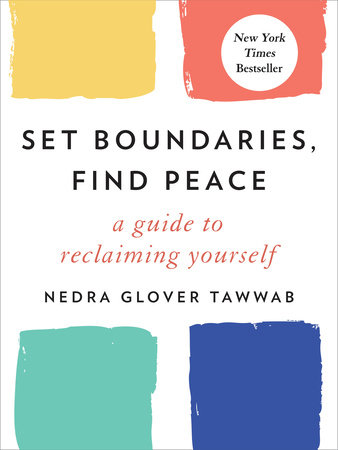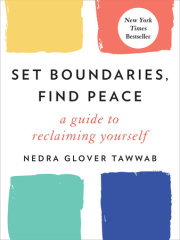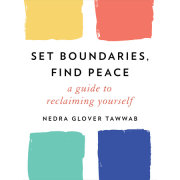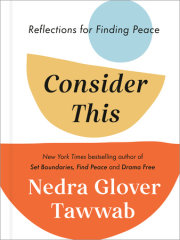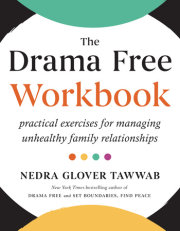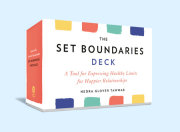1
What the Heck Are Boundaries?
Boundaries are the gateway to healthy relationships.
"I feel overwhelmed," Kim said, burying her head in her hands. She had started seeing me two weeks after she had returned from her honeymoon. Newly married and excelling in her career, Kim prided herself on being the best at everything she did, but her worries about getting it all done had become all-consuming. She was depleted and dreaded getting out of bed in the morning. She not only was determined to be the best for herself, but she also always showed up as the "best" for others: the best friend, best daughter, best sister, best coworker. Now she wanted to be the best wife. And someday, the best mother. Being the best for Kim meant always saying yes. Saying no was mean. Saying no was selfish. She came to me hoping to figure out how to do more without feeling so exhausted.
On my couch, Kim went down the list of things she had agreed to do for other people in the coming week. She insisted that her friend needed her help to move. Her coworker would not be able to manage his project without her assistance. Kim was eager for solutions. She was trying to create more time to do all the things she'd signed up for.
As she rattled off everything she was trying to figure out, I asked her to pause. I gently pointed out that it was impossible to create more time. She looked a bit stunned at first. "Don't worry," I said. "I can help you lighten your load instead." From the look on her face, it seemed as though this approach had never occurred to her. I wasn't surprised. I meet so many people-especially women-who give and give so much, only to feel exhausted and even depressed as a result. This is why we live in a culture of burnout.
To start, I encouraged Kim to make a list of everything she needed to do at work and home that week. She already had her week completely mapped out (of course she did). She sketched a schedule for completing each task. She quickly saw that there was simply not enough time to do all the things she had planned.
I asked her, "What do you really have to do, and what can you delegate? Do you think your friend might be able to find someone else to help them move?" She mulled it over and said yes, but insisted that she wanted to help. At that moment, I could see that Kim had an issue with setting boundaries around how much and how often she's willing to help others and that this was contributing to her anxiety. She meant well, right? All she wanted to do was help people! But her level of willingness to help was impossible to sustain. She desperately needed to do less. When I mentioned delegating, Kim dismissed the idea immediately. She knew only one way to help others, and that was to say yes to doing it herself.
Kim's refusal to say no had led her to my office and was the root of her worry, stress, and crippling anxiety. According to studies, anxiety is rising. Complicated relationships are among the leading causes of increasing rates of anxiety, and anxiety and depression are the two most common reasons people pursue therapy. Just like Kim, people enter therapy when anxiety is starting to impact their daily life.
I worked with Kim to unpack her need to be present for everyone. I helped her see that saying no would give her the time she was seeking. Saying no would give her the freedom to settle into her role as a wife. Saying no would reduce her worry so that she could get out of bed and face the day without immediately feeling overwhelmed.
My Definition of "Boundaries"
Boundaries are expectations and needs that help you feel safe and comfortable in your relationships. Expectations in relationships help you stay mentally and emotionally well. Learning when to say no and when to say yes is also an essential part of feeling comfortable when interacting with others.
Signs That You Need Healthier Boundaries
Kim's ability to function was impacted by her constantly replaying her thoughts, planning, worrying about having enough time, and dreading getting started. In short, she was stressed out.
Mental health issues such as anxiety can be prompted by our neurological response to stress. When we are stressed, our brain has difficulty shutting down. Our sleep is affected. Dread sets in. As a therapist, I observe poor self-care, feelings of being overwhelmed, resentment, avoidance, and other mental health issues as common presentations of boundary issues.
Neglecting Self-Care
We've all heard the analogy from airplane-safety language: "Put on your oxygen mask first before helping others." Simple, right? Nope. Neglecting self-care is the first thing to happen when we get caught up in our desire to help others.
I can't tell you how many people show up in my office lamenting, "I don't have time to do anything for myself." After a quick evaluation, it becomes apparent that these people are not making any time for themselves. In fact, it often seems like they've forgotten how to take care of themselves. They can't manage to carve out time to eat a healthy meal or find five minutes to meditate, but they spend hours volunteering at their kids' school every week. This type of imbalance is an immediate sign of boundary issues.
Self-care is more than taking a spa day, and it isn't selfish. Saying no to helping is an act of self-care. Paying attention to your needs is self-care. And like putting on the oxygen mask, you'll have more energy for others if you apply it to yourself first. If you think about it, the root of self-care is setting boundaries: it's saying no to something in order to say yes to your own emotional, physical, and mental well-being.
The root of self-care
is setting boundaries.
Overwhelmed
Kim sought therapy because she was feeling chronically overwhelmed. This is one of the most common manifestations of boundary issues. Overwhelmed people have more to do than the time required for their tasks. They are drowning in thoughts about squeezing more into an already packed schedule. This type of busyness is endemic in our culture. Everyone is striving to do more and more. Time is an afterthought. But our well-being is the price. Understanding boundaries is a proactive way to gauge what is truly manageable, and it also allows you to give 100 percent to the task at hand without that nagging sense of feeling overwhelmed all the time.
Resentment
Feeling taken advantage of, frustrated, irritated, annoyed, and bitter is the result of the resentment we feel when we don't set limits. Being resentful impacts the way we deal with people. It doesn't allow us to be our best selves in our relationships. It breeds conflict. It makes us paranoid. It puts up a wall. Long-term resentment affects how we perceive the intentions of others. When we're resentful, we do things out of obligation to others instead of for the joy of helping. Resentment can be palpable.
If a client comes in and says, "I have to take care of my mother, and I feel angry about it," I can immediately pick up on the irritation and resentment. Exploring why they perceive pressure and obligation to provide this care allows me to challenge my client's belief. Yes, they want their mother to be taken care of, but they don't have to be the only person providing that care. Implementing boundaries-through asking for support from other family members and delegating-can help alleviate stress.
Remember the signs that you need boundaries:
You feel overwhelmed.
You feel resentful toward people for asking for your help.
You avoid phone calls and interactions with people who might ask for something.
You make comments about helping people and getting nothing in return.
You feel burned out.
You frequently daydream about dropping everything and disappearing.
You have no time for yourself.
Avoidance
Disappearing, ignoring, or cutting people off is avoidance. Not responding to a request, delaying setting the record straight, or failing to show up are ways that we avoid situations instead of dealing with them proactively. But prolonging issues by avoiding them means the same issues will reappear over and over again, following us from relationship to relationship.
Avoidance is a passive-aggressive way of expressing that you are tired of showing up. Hoping the problem will go away feels like the safest option, but avoidance is a fear-based response. Avoiding a discussion of our expectations doesn't prevent conflict. It prolongs the inevitable task of setting boundaries.
Thoughts of fleeing-"I wish I could drop everything and run away"-are a sign of extreme avoidance. Fantasies of spending your days alone, ignoring calls, or hiding means you are seeking avoidance as the ultimate answer. But creating boundaries is the only real-life solution.
Learning to be assertive about your limitations with others will help you eliminate these symptoms and manage bouts of depression and anxiety. A lack of understanding about boundaries breeds unhealthy habits. So let's break it down.
Understanding Boundaries
Creating healthy boundaries leads to feeling safe, loved, calm, and respected. They are an indication of how you allow people to show up for you and how you show up for others. But it doesn't stop there.
The Meaning of Boundaries
They are a safeguard to overextending yourself.
They are a self-care practice.
They define roles in relationships.
They communicate acceptable and unacceptable behaviors in relationships.
They are parameters for knowing what to expect in relationships.
They are a way that you ask people to show up by upholding your needs.
They are a way to communicate your needs to others.
They are a way to create healthy relationships.
They are a way to create clarity.
They are a way to feel safe.
A boundary is a cue to others about how to treat you. It can be explicit, such as saying "I'm about to share something that I'd like you to keep between just the two of us." Or implicit, such as having a basket for shoes and socks right by the front door for guests. As you set your own limits, it's important to remain aware of the boundaries people are trying to communicate to you as well.
Our family histories and personalities determine how we implement and accept boundaries. If your family operates on unspoken limits or regularly ignores limits, you will probably grow up lacking the communication skills necessary to be assertive about your needs. For instance, adult children of alcoholics can have a difficult time setting limits. Parents with addiction issues often send the message that a child's boundaries are not more significant than the parent's addiction. So these children grow up struggling to understand and define limits. If your family of origin communicates and respects healthy limits, you are likely more comfortable defining them in any scenario.
Personality determines our comfort level with respecting and rejecting boundaries. People with anxious tendencies are more prone to overreact when challenged. Emotional regulation is a common issue, as these people are unable to react appropriately given the situation. People who exhibit strong signs of being disagreeable, such as always having to be right, arguing over small details, or struggling to accept differences in others, are more likely to push back against boundaries. Openness (receptiveness to change) and consciousness (willingness to learn and grow) are personality traits of people who are more likely to respect limitations.
Boundaries are essential at all ages. They change in relationships, just as the people in relationships change. Transitions such as getting married, going away to college, or starting a family often require new ones.
There are actually three levels of boundaries. See if any of these sound familiar to you.
Porous
Porous boundaries are weak or poorly expressed and are unintentionally harmful. They lead to feeling depleted, overextending yourself, depression, anxiety, and unhealthy relationship dynamics. Kim from the opening story is an example of how porous boundaries can manifest and damage well-being.
Porous boundaries look like
Oversharing
Codependency
Enmeshment (lacking emotional separation between you and another person)
Inability to say no
People-pleasing
Dependency on feedback from others
Paralyzing fear of being rejected
Accepting mistreatment
Examples of porous boundary setting:
Saying yes to things you don't want to do
Loaning money to people because you feel obligated or when you don't have the funds to do so
Rigid
At the other extreme, rigid boundaries involve building walls to keep others out as a way to keep yourself safe. But staying safe by locking yourself in is unhealthy and leads to a whole other set of problems. Whereas porous boundaries lead to unhealthy closeness (enmeshment), rigid ones are a self-protective mechanism meant to build distance. This typically comes from a fear of vulnerability or a history of being taken advantage of. People with rigid boundaries do not allow exceptions to their stringent rules even when it would be healthy for them to do so. If a person with rigid boundaries says, "I never loan money to people," they never stray from that, even if a friend who isn't the type to borrow money is in a crisis.
Rigid boundaries look like
Never sharing
Building walls
Avoiding vulnerability
Cutting people out
Having high expectations of others
Enforcing strict rules
Examples of rigid boundary setting:
Saying no harshly as a way to discourage people from asking you in the future
Having a rule that you never watch your sister's kids
Healthy
Healthy boundaries are possible when your past doesn't show up in your present interactions. They require an awareness of your emotional, mental, and physical capacities, combined with clear communication.
Healthy boundaries look like
Being clear about your values
Listening to your own opinion
Sharing with others appropriately
Having a healthy vulnerability with people who've earned your trust
Being comfortable saying no
Being comfortable hearing no without taking it personally
Examples of healthy boundary setting:
Saying no without apologizing because it's the healthiest choice for you at that moment
Supporting people financially, when appropriate, and when you can do so without causing financial harm to yourself
Two Parts to Setting Boundaries
It's true that setting boundaries isn't easy. Paralyzing fear about how someone might respond can easily hold us back. You might play out awkward interactions in your mind and prepare yourself for the worst possible outcome. But trust me: short-term discomfort for a long-term healthy relationship is worth it every time!
Whenever you identify a boundary you'd like to set, remember that there are two steps to the process: communication and action.
Communication
Verbally communicating your needs is step one. People cannot accurately assume your boundaries based on your body language or unspoken expectations. When you explicitly state what you expect, there is little room for others to misinterpret what works for you. Assertive statements are the most effective way to do this.
Copyright © 2021 by Nedra Glover Tawwab. All rights reserved. No part of this excerpt may be reproduced or reprinted without permission in writing from the publisher.

